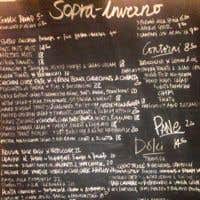This article was also published in the Financial Times.
ZUNI CAFÉ, SAN FRANCISCO
This menu excites me visually on several fronts.

Firstly, I can immediately spot those dishes that I would only want to eat sitting here in the California sunshine: the house-cured anchovies with celery; the bowl of polenta with mascarpone; and Zuni's longest-running dishes, their Caesar salad and the roast chicken for two cooked in the brick oven.
Then this menu effortlessly takes me on a tour of those farms which, if they have passed the scrutiny of Zuni's owners Judy Rodgers and Gilbert Pilgram and their chefs, will necessarily be the most reliable producers: Watson Ranch for lamb; Wolfe Ranch for quail; and Evans Ranch for their beef. Not to mention the chorizo cured by Rymee Trobaugh, Zuni's kitchen manager.
Finally, it is admirably concise and easy to navigate. The list of aperitifs, sodas, beers and coffee included in small but legible print at the bottom makes all those separate pieces of paper that clutter up so many restaurant tables completely unnecessary. Pick up this menu, sit back and relax.
QUO VADIS, SOHO, LONDON
This menu makes me smile while I ponder what I will ultimately order. But it is also an example of the power of excellent design.

The courage restaurateurs Sam and Eddie Hart displayed in taking over this rambling restaurant was not matched by their sense of timing post 2008. They then subsequently brought in Jeremy Lee as head chef, who in turn brought in designer Julian Roberts of Irving & Co, who works round a central, changing illustration by John Broadley. Collectively they have transformed the business.
This menu takes the eyes and stomach on a gentle tour. Top left are 'kickshaws', hot, pinched parcels made from scraps of puff pastry filled with minced chicken (the recipe is from Lee's Scottish mother while the word kickshaws is a corruption of the French quelque chose). Centre stage is that day's menu, a well-balanced choice of five starters and main courses; and around the outside are dishes to appeal to those with particularly small or large appetites. And, because this is Soho, there is always a theatre menu.
CAFÉ SOPRA, FRATELLI FRESH, SYDNEY
The menu here is the blackboard, the most immediate medium for conveying what is fresh, in season and the result of the chefs' collective creativity.

Blackboard menus have long been the mainstay of brasseries throughout France, and I have only the happiest memories of the menus explained to me by the waiting staff at Bistrot Paul Bert in Paris as they carry the blackboards from table to table.
But this menu from one of my favourite places in Sydney conveys even more. Because the cafés are located next to shelves of colourful produce there is an extra layer of culinary excitement as these blackboards signal how the fruit, vegetables, herbs and salads will be so rapidly transformed and brought to your table.
Blackboard menus also appeal because they seem timeless and yet reflect, from the manner in which they are written, the elegant hand of a particular member of staff. 21st-century technology has not created an equally low-cost substitute, although the practice of projecting the menu on to a wall via a laptop as at Monvínic, Barcelona, will doubtless become increasingly common.
TAILLEVENT, PARIS
I am so fond of this menu (photo by Luke Albert) that it has lain in my office for many years, as is obvious from two immediate facts.

The more obvious is that it is priced in French francs, so it dates back to the pre-euro era of the last century. The second is that the fish section is so extensive, reflecting a time when top-quality fish was in far more abundant supply than it is today.
But if this menu from Taillevent in Paris, one of the world's most elegant restaurants, appears old by these two standards, it is in every other respect the epitome of clear design; of how the restaurateur, by putting himself in the seat of the customer, can create a menu that is comprehensive and democratic. A menu, above all, that exudes a sense of occasion.
Although the menu at Taillevent today lacks the woodcuts that adorn this version (it was redesigned by its late owner Jean-Claude Vrinat to mark the restaurant's 60th birthday), it still follows the same principles.
It is large format and spread over four pages. The opening page covers the first and main courses, the final pages the desserts. The interleaving pages convey what are the main highlights of what has always been an exceptional wine cellar (the restaurant today is owned by the Gardinier family, who also own Château Phélan Ségur in Bordeaux).
This layout immediately ensures that every customer is treated identically. There is no separate wine list handed to the presumed host or hostess and this, in turn, means that there can be a lively discussion between all those around the table as to which wines are going to be enjoyed. Despite the prices, all are treated equally here.
And this is a menu that through its size and design conveys a sense of pure pleasure. Once Jean-Marie Ancher, Taillevent's long-standing maître d', hands you your menu and you hold it up to take in what is on offer, the size of the menu encloses you in your own world where there is just you, the menu and your appetite. Conversation round the table comes to an end as eye contact is effectively broken.
No menu I have ever come across so directly or effortlessly demands the customer's full concentration even if, as with the contents of every fascinating menu, making that final decision as to what to choose is always tantalisingly difficult.

